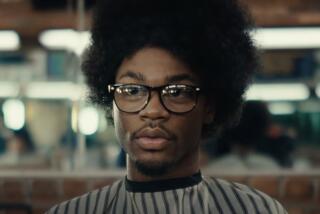ADVERTISING & MARKETING : Carl’s Jr. to Spice Up Spanish Ads : Fast food: New commercials based on longtime campaign add bold beat and effects not found in most spots aimed at Latinos.
- Share via
Carl’s Jr. is about to tackle one of the advertising industry’s toughest challenges: pumping new life into a long-running advertising campaign that’s begun to show its age.
Since its debut early in 1995, the burger chain’s Spanish-language ads have been credited with driving sales increases in Latino neighborhoods that regularly outpace general market growth. But sales slowed earlier this year, and market research showed that consumers were tiring of the commercials that use traditional Latino music, costumes and dances to pitch the Anaheim-based company’s burgers.
The crisp, white backgrounds found in previous commercials are there in the two new ads that debut this week on Spanish-language television. But the music has a bolder beat, dancers wear apparel that would be at home in Ricky Martin’s closet, and the spots incorporate digital effects not found in most Spanish-language commercials.
Some ad campaigns never seem to run out of energy--Wendy’s International founder Dave Thomas recently completed his 650th commercial in a 10-year campaign for the Columbus, Ohio-based fast-food chain. Others, such as those featuring Speedy Alka-Seltzer and the California Raisins, eventually checked into the rest home for elderly ad icons.
“When you’ve got a good concept, it’s a matter of keeping the execution fresh, keeping the good things that have made people familiar with your brand,” said UCLA marketing professor Carol Scott. “You’ve got something called ‘wear-out,’ which happens when people get tired of the same execution.”
Blending key parts of the existing campaign with new elements “is very hard to do,” said Diane Cook-Tench, director of the Adcenter at Virginia Commonwealth University in Richmond, Va. Anheuser-Busch’s introduction of talking lizards into a campaign featuring frogs that chanted “Bud . . . weis . . . er” is one example of a strategy that extended a campaign’s life span, Cook-Tench said.
Carl’s Jr., which spent the first half of the decade scrambling for an identity, clearly hit pay dirt early in 1995 when Los Angeles-based Mendelsohn/Zien and Santa Monica-based Anita Santiago Advertising developed the company’s current campaigns. “The advertising has been wonderful for five years,” said Diane Hays-Hoag, vice president of marketing for CKE Restaurants Inc., the chain’s parent company. “That’s longer than most people get out of a single campaign--and we’ve had two successful campaigns.”
Carl’s Jr.’s decision to take a scalpel to its Spanish-language ad campaign comes at a time when its overall sales have stalled in the face of growing competition from such companies as McDonald’s Corp., which are using new products and discounts to lure customers.
Some industry insiders say Carl’s Jr. may have to dramatically reshape its general-market campaign that uses messy burgers, edgy humor and sexual innuendo to pitch burgers to young males, fast food’s core demographic. Carl’s Jr., which has forecast lower sales for the fourth quarter, “is not where we want to be right now,” Hays-Hoag said. “We’ve met with Mendelsohn/Zien, and we’re basically in an open-forum discussion of where to take our advertising.”
Although Carl’s Jr. is reviewing its general-market campaign, the chain won’t stray far on the Latino front, because its market research suggests that consumers still enjoy that campaign’s emphasis on Latino music, bright costumes and lively dancing. Said Hays-Hoag: “They just want us to do things a little bit different.”
The two campaigns are distinct because they target different demographics. The big-and-messy approach has played well with young males. The Latino campaign created by the Anita Santiago agency is aimed at mothers who play a dominant role in determining when and where families eat out.
Agency founder Anita Santiago cautioned Carl’s Jr. in 1995 that the quirky humor of the youth-oriented general-market campaign wouldn’t translate into effective Latino advertising. Nearly five years later, she and other ad industry players say that’s still the case.
“ ‘Big and sloppy’ isn’t going to appeal to many Hispanics who would find it offensive,” said Carlos Garcia, president of Garcia Research Associates, a Burbank firm that studies the effectiveness of commercials. “You can have humor with an edge in it, but it would probably have to be a different type of humor. But you don’t want to offend these people.”
Although Carl’s Jr. doesn’t want to stray too far from its Latino campaign, during preproduction meetings at the company’s Anaheim headquarters, Santiago described plans to incorporate elements not previously seen. Past commercials relied on straight-ahead shots of dancers, but the new spots would experiment with a digital technology that allows several images of the same dancer to appear on screen at the same time. Santiago also incorporated a technology in which one scene is “crumpled” into the next.
Product shots always are important to restaurants, so the camera constantly focuses on the chain’s Super Star and Sourdough Bacon burgers. The commercials also incorporate lyrics that tell consumers what’s inside the sandwiches, an important element, Santiago said, for consumers who haven’t grown up eating hamburgers.
The new commercials include several style references to Martin, the popular Puerto Rican singer who is helping to set fashion and musical tastes across the cultural spectrum.
Hays-Hoag said the new commercials will be closely monitored to ensure that they’re sending the right message: “This is a hugely important part of our business, and we need to continually be getting into the minds of consumers to see what’s going on in Hispanic culture.”
More to Read
Eat your way across L.A.
Get our weekly Tasting Notes newsletter for reviews, news and more.
You may occasionally receive promotional content from the Los Angeles Times.










